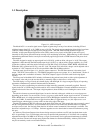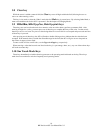
BK Precision 4071 User Manual Rev.2.2
6
4. External Trigger/Gating/FSK/BPSK input
The External Trigger/Gating/FSK/BPSK In connector accepts an external digital signal on the rear of the unit as
illustrated here:
Figure 2.0-4: Driving the Ext Trigger/Gating/FSK/BPSK input
On this connector the user supplies a digital signal, which serves a variety of purposes, depending on the operating
mode of the 4071.
This input is a high impedance input (about 80KO) and can safely accept input levels from -10V to +10V. The
input uses a comparator with a switching point of about 1.4V permitting either TTL or CMOS logic to drive this
input. The input has hysterics, too, so you can apply analog signals to this input (i.e. a sinewave).
This input has an internal pull down resistor which holds it in the low or "0" state when left open.
In most modes, this input can be used to switch the output signal on or off. When driven high, the output signal is
gated off. This function can be performed up to 3 MHz. When the output is gated off, the DC level on the Sig Out
jack is unpredictable. The Gating input "freezes" the output waveform at the output voltage is held to the voltage
value that existed at the moment the Gating input went high. When the Gating input is brought low again, the output
waveform resumes from the same point.
In the External FSK and BPSK modes, this input is used to bring in digital data for FSK or BPSK modulation.
In the Burst and Triggered Sweep modes, this input is used as a trigger signal. External High logic signal will
triggers a sinewave burst or starts a sweep.
In the Continuous Sweep mode, driving this input high can halt the sweep. The sweep will resume when this input
is brought low again.
In the Arbitrary, Function, and Pulse Generator modes, this input serves as a trigger signal input. If Triggered
mode is selected, the generation of your arbitrary/function/pulse waveform will commence on the rising edge of the
trigger signal.
*** Caution ***
Be careful to ensure that the input signal does not exceed the +/- 10V limit. Permanent damage to this input may
result by exceeding this input voltage limit.


















